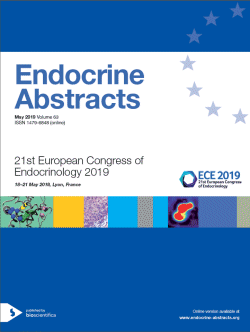Searchable abstracts of presentations at key conferences in endocrinology

21st European Congress of Endocrinology
Lyon,
France
18 May 2019 - 21 May 2019
18-21 May 2019, Lyon, France
Symposia
What's new in reproductive endocrinology?
ea0063s27.1 | What's new in reproductive endocrinology? | ECE2019
Dissecting androgens in Polycystic Ovary Syndrome (PCOS)
Polycystic ovary syndrome (PCOS) is a common hormonal disorder characterised by reproductive hormone dysregulation involving luteinising hormone (LH) hypersecretion and hyperandrogenism, as well as reduced fertility, due to ovulatory disturbance. In addition, women with PCOS are also predisposed to metabolic disturbances such as obesity, insulin resistance, and dyslipidemia, with an increased risk of cardiovascular disease and type 2 diabetes. Currently, as the origins of PCOS...
ea0063s27.2 | What's new in reproductive endocrinology? | ECE2019
Large scale genetic studies in male infertility
Infertility affects 1015% of couples. In about half of them, a descriptive cause can be established in the male partner, mostly reduced sperm output, of which azoospermia, the complete lack of spermatozoa in the ejaculate, is the most severe form. Non-obstructive azoospermia (NOA) comprises several subforms of spermatogenic failure, such as meiotic arrest (MeiA) and Sertoli-Cell-Only syndrome (SCOS). Most of these phenotypes are suspected to be of genetic origin. However...
ea0063s27.3 | What's new in reproductive endocrinology? | ECE2019
Menopause and cardiovascular risk
The transition to menopause is characterised by a decrease in circulating estradiol, relative androgen excess and a decrease in sex hormone-binding globulin concentrations. These hormonal changes are frequently accompanied by an increase in body weight, central obesity, dyslipidemia, insulin resistance and an increase in blood pressure. Aging, comorbidities, depression and inactivity further contribute to the increase in cardiovascular risk after the menopause. Beyond traditio...



